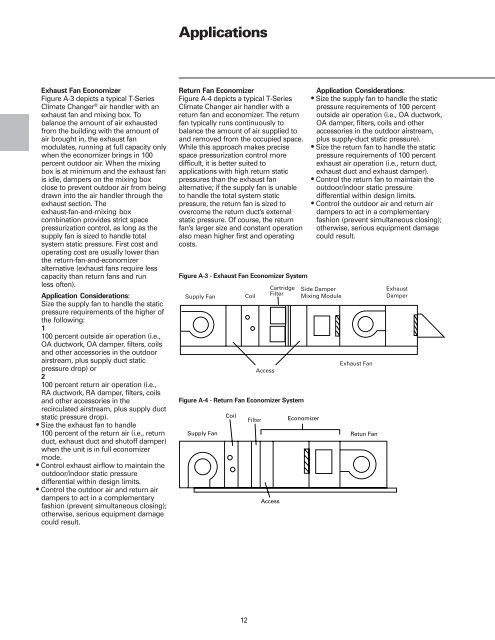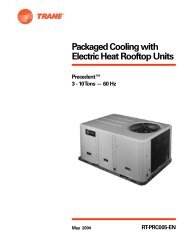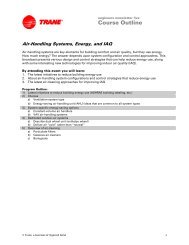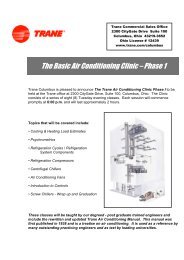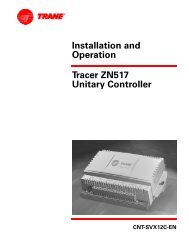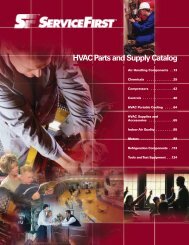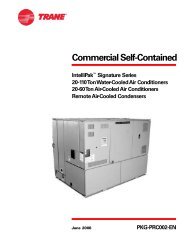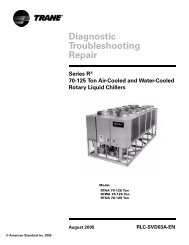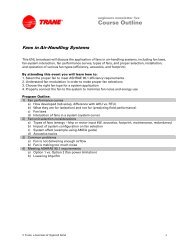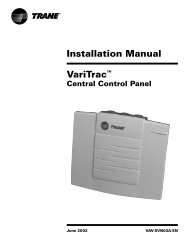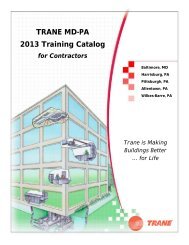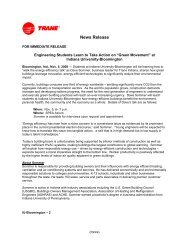T-Series Climate Changer ® Air Handlers Sizes 3 through ... - Trane
T-Series Climate Changer ® Air Handlers Sizes 3 through ... - Trane
T-Series Climate Changer ® Air Handlers Sizes 3 through ... - Trane
You also want an ePaper? Increase the reach of your titles
YUMPU automatically turns print PDFs into web optimized ePapers that Google loves.
Exhaust Fan Economizer<br />
Figure A-3 depicts a typical T-<strong>Series</strong><br />
<strong>Climate</strong> <strong>Changer</strong> <strong>®</strong> air handler with an<br />
exhaust fan and mixing box. To<br />
balance the amount of air exhausted<br />
from the building with the amount of<br />
air brought in, the exhaust fan<br />
modulates, running at full capacity only<br />
when the economizer brings in 100<br />
percent outdoor air. When the mixing<br />
box is at minimum and the exhaust fan<br />
is idle, dampers on the mixing box<br />
close to prevent outdoor air from being<br />
drawn into the air handler <strong>through</strong> the<br />
exhaust section. The<br />
exhaust-fan-and-mixing box<br />
combination provides strict space<br />
pressurization control, as long as the<br />
supply fan is sized to handle total<br />
system static pressure. First cost and<br />
operating cost are usually lower than<br />
the return-fan-and-economizer<br />
alternative (exhaust fans require less<br />
capacity than return fans and run<br />
less often).<br />
Application Considerations:<br />
Size the supply fan to handle the static<br />
pressure requirements of the higher of<br />
the following:<br />
1<br />
100 percent outside air operation (i.e.,<br />
OA ductwork, OA damper, filters, coils<br />
and other accessories in the outdoor<br />
airstream, plus supply duct static<br />
pressure drop) or<br />
2<br />
100 percent return air operation (i.e.,<br />
RA ductwork, RA damper, filters, coils<br />
and other accessories in the<br />
recirculated airstream, plus supply duct<br />
static pressure drop).<br />
• Size the exhaust fan to handle<br />
100 percent of the return air (i.e., return<br />
duct, exhaust duct and shutoff damper)<br />
when the unit is in full economizer<br />
mode.<br />
• Control exhaust airflow to maintain the<br />
outdoor/indoor static pressure<br />
differential within design limits.<br />
• Control the outdoor air and return air<br />
dampers to act in a complementary<br />
fashion (prevent simultaneous closing);<br />
otherwise, serious equipment damage<br />
could result.<br />
Applications<br />
Return Fan Economizer<br />
Figure A-4 depicts a typical T-<strong>Series</strong><br />
<strong>Climate</strong> <strong>Changer</strong> air handler with a<br />
return fan and economizer. The return<br />
fan typically runs continuously to<br />
balance the amount of air supplied to<br />
and removed from the occupied space.<br />
While this approach makes precise<br />
space pressurization control more<br />
difficult, it is better suited to<br />
applications with high return static<br />
pressures than the exhaust fan<br />
alternative; if the supply fan is unable<br />
to handle the total system static<br />
pressure, the return fan is sized to<br />
overcome the return duct’s external<br />
static pressure. Of course, the return<br />
fan’s larger size and constant operation<br />
also mean higher first and operating<br />
costs.<br />
Figure A-3 - Exhaust Fan Economizer System<br />
Figure A-4 - Return Fan Economizer System<br />
12<br />
Application Considerations:<br />
• Size the supply fan to handle the static<br />
pressure requirements of 100 percent<br />
outside air operation (i.e., OA ductwork,<br />
OA damper, filters, coils and other<br />
accessories in the outdoor airstream,<br />
plus supply-duct static pressure).<br />
• Size the return fan to handle the static<br />
pressure requirements of 100 percent<br />
exhaust air operation (i.e., return duct,<br />
exhaust duct and exhaust damper).<br />
• Control the return fan to maintain the<br />
outdoor/indoor static pressure<br />
differential within design limits.<br />
• Control the outdoor air and return air<br />
dampers to act in a complementary<br />
fashion (prevent simultaneous closing);<br />
otherwise, serious equipment damage<br />
could result.


